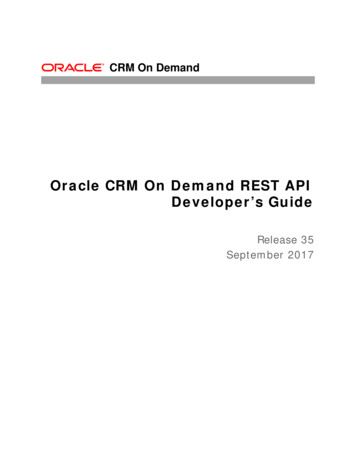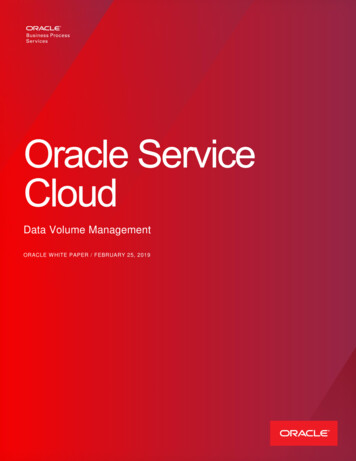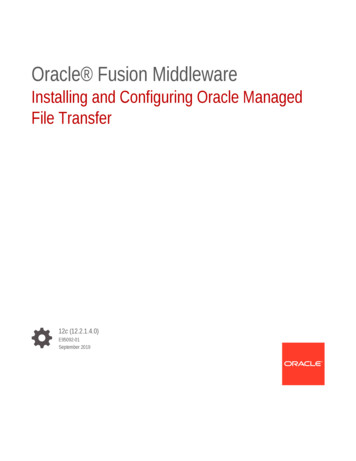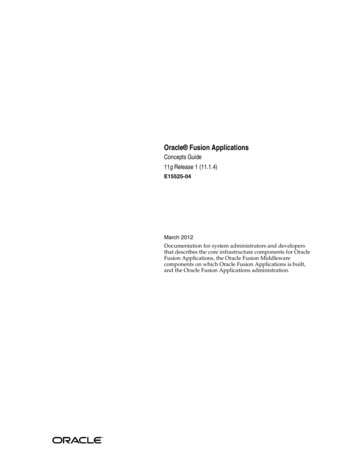
Transcription
Data SheetOracle Fusion Cloud DemandManagementReplenishment PlanningWhether you’re restocking surgical supplies in a hospital chain,distributing phone accessories to stores, or delivering spare parts to alarge installed base, you need to anticipate demand and replenishsupply strategically. Oracle Fusion Cloud Demand Management’sReplenishment Planning features segment items, organizations, andcustomer sites into groups with similar consumption patterns, so youcan manage replenishment through policy settings. Real-timeanalytics highlight any shortages or overstocks, and on-linesimulation and inventory rebalancing helps you correct issues beforethey impact your business.Meet replenishment challengesAs supply chain complexity continues to increase, enterprises must innovate tobetter match supply with demand. When it comes to replenishing stockrooms,depots, stores, or periodic automatic replenishment (PAR) locations, thechallenge is to consistently satisfy your consumers. You want to ensure that theyfind the desired product at the right place at the right time, while minimizinginventory investment and logistics costs. Poor replenishment planning can resultin stockouts that reduce customer satisfaction and sales. It can also lead tooverstocks that reduce productivity, product freshness and margins.Figure 1. Automatically restock downstream stores, stockrooms, depots, and PAR locationsDemand Management's Replenishment Planning features help you predictconsumption and meet replenishment challenges. It has world class forecasting1Solution Brief / Oracle Fusion Cloud Demand Management – Replenishment PlanningCopyright 2022, Oracle and/or its affiliatesKey business benefits Respond more effectively tochanges and unplannedevents Improve customer servicelevels Minimize stockouts in stores,stockrooms, PAR locations
capabilities that anticipate trends, seasonal demand changes, and causal events.It’s also integrated with Oracle Fusion Cloud Supply Chain Execution, giving youimmediate visibility into inventory and planned movements.Segment the supply chain with flexible rulesSegmentation is a powerful strategy that helps mitigate inherent complexity inthe supply chain. Segments identify groups of similar-performing item-locationcombinations and associate them with a common process or inventory policy toincrease revenue, improve service levels and reduce costs. ReplenishmentPlanning’s rules-based segmentation scheme dynamically classifies itemlocations into groups or segments using static, dynamic, or configuredattributes. You can use multiple segment schemes depending upon businessconditions.Figure 2. The Replenishment Planning work area summaries your segment performanceManaging by segment simplifies configuration and allows you to maintain yourplans at a higher level. Built-in analytics summarize performance by segment,and let you drill down to review and analyze individual item-locationcombinations at the most granular level.Tailor inventory policy planning to demand segmentsReplenishment Planning inventory policies help drive the inventory levelsneeded to meet your target service levels for demand fulfillment. You can createa reusable inventory policy profile and associate it to one or more segments. Allitem-locations within a segment inherit the same inventory policy.With Replenishment Planning, you can also compare the newly calculatedinventory policies with existing, in-force policies at the item-location level.Between two successive computations of inventory policy parameters, theforecast may change, or a new event may cause a spike in demand, so you mayneed to consider changes to your inventory policy parameters. If the policyvalues are outside the defined threshold, you can follow a systematic policyreview process to accept, retain, or manually override the new policy values.2Solution Brief / Oracle Fusion Cloud Demand Management – Replenishment PlanningCopyright 2022, Oracle and/or its affiliatesKey features Divide item-locations intomanageable segments Specify inventory policiesand compute demand-drivenreplenishments Monitor performance,simulate changes, and takeactions
Summary analytics help you review the effectiveness of the assigned inventorypolicies at the segment level.Related products Oracle Fusion Cloud Sales &Operations Planning alignsbusiness plans andoperations across the sales,marketing, finance, andsupply chain organizations. Oracle Fusion Cloud SupplyChain Collaboration sharesorder forecasts withsuppliers and collaborates ontheir supply commitments. Oracle Fusion Cloud OrderManagement centralizesand standardizes your orderfulfillment across multiplesales channels.Figure 3. The Replenishment Planning work area summaries your policy effectivenessCalculate demand-driven replenishmentsReplenishment Planning accounts for uncertainty in demand and lead times,along with current inventory thresholds, when calculating replenishment ordersto restock facilities. The replenishment orders maintain inventory positions at orabove your defined thresholds and you can calculate inventory policyparameters and replenishments for specific segments or organizations.Replenishment orders are generated whenever the inventory position falls belowthe minimum threshold. Based on the specified inventory policy, thereplenishment order may be a fixed order quantity or computed quantity,calculated as a difference between the maximum threshold and inventoryposition. The computed order quantity is adjusted for order minimum and ordermultiple.Simulate replenishment outcomesAt any time during the planning process, you can run the plan to simulatereplenishments. The system applies your inputs and edits to calculatereplenishment orders based upon the latest data. You can perform the followingsimulations in Replenishment Planning: Identify inventory policy or parameter alternatives that maximize theperformance based on input targets, such as service levels, fill rates, andinventory cost. You can make changes to the policy or policy parameter andcompare metrics such as projected fill rates, inventory details, inventorycarrying cost, and inventory shortages. Compare baseline and simulation plans to evaluate the impact of planchanges. You can change supply and demand, dates, and quantities thatimpact a replenishment plan and monitor their effects.3Solution Brief / Oracle Fusion Cloud Demand Management – Replenishment PlanningCopyright 2022, Oracle and/or its affiliates Oracle Fusion Cloud SupplyChain Execution defines andexecutes production,shipping, receiving, transfers,and other execution activitiesacross the global supplychain. Oracle Fusion CloudProcurement integratessourcing, contracts andpurchasing of goods andservices.
Define simulation sets to manage replenishment plan changes and applythem to one or more plans. You can associate a simulation set with any planthat needs evaluation including inventory policy, inventory policyparameters, supply, demand dates, and quantities.Leverage strategic Inventory rebalancingDemand volatility, shipment delays, and invalid parameter settings can causeitem shortages at multiple locations, while leaving others with excess inventory.Replenishment Planning quickly responds to these imbalances by movinginventory among stores or depots when excess is available, rather thanprocuring from upstream warehouses or suppliers. Inventory rebalancing cansave you time and money by dealing with shortages locally, while providingbetter service to your customers.Figure 4. The Replenishment Planning work area summarizes your cluster performanceInventory rebalancing is performed within a cluster, which is a group of locationswithin your replenishment network. Within a cluster, the algorithm computes theexcess and shortage of each item at each location for a pre-defined period.Excess is allocated to locations with a shortage, and transfer recommendationsare generated from excess locations to shortage locations (adjusted for orderminimum and order multiple) if a shipping lane exists. You can also designate a“sweep” location to balance inventory across nested clusters.Execute the replenishment planYou can tailor replenishment plans to meet your business goals by: 4Using demand forecasts as the seed to compute inventory policy parametersand generate replenishment orders. The demand forecast may be anexternal forecast schedule or generated within the application. You can alsouse shipment history or consumption history collected from Oracle FusionCloud Supply Chain Execution to generate the forecasts.Solution Brief / Oracle Fusion Cloud Demand Management – Replenishment PlanningCopyright 2022, Oracle and/or its affiliates
Performing automated replenishment using transactional data, such as salesorders, inventory on-hand, and purchase orders from Oracle Fusion CloudSupply Chain Management. This data is collected in net-change mode,enabling fast, frequent plan runs for item-locations with changes in supplyor demand.When you’re satisfied with the results, you can release the orders to OracleFusion Cloud Supply Chain Execution for transfer orders or movement requestsand Oracle Fusion Cloud Procurement for purchase orders to be created. Youcan also set up auto approval rules to release replenishment ordersautomatically after the plan run.Demand Management Cloud: Replenishment PlanningConsumptionDownstreamDemand SourcesReplenishmentsItem AttributesProduct HubFile-Based ntegratedFigure 5. Replenishment Planning is tightly integrated with Oracle Fusion Cloud Supply Chain ManagementExtend replenishment planning processes as you see fitReplenishment Planning is seamlessly integrated with Oracle Fusion CloudSupply Planning, enabling you to forecast demand and plan supply in a single,cloud-based supply chain planning platform.Replenishment Planning allows you to extend the solution for your uniquebusiness requirements. You can configure your own data analysis using customtime series data and configurable charts, graphs, and tables. A series of RESTApplication Programming Interfaces (API) allow you to build two-way integrationwith custom extensions to any on-premise supply chain execution application.To learn more about Replenishment Planning and the other capabilitiesof Oracle Fusion Cloud Demand Management, anagement.5Solution Brief / Oracle Fusion Cloud Demand Management – Replenishment PlanningCopyright 2022, Oracle and/or its affiliates
Connect with usCall 1.800.ORACLE1 or visit oracle.com. Outside North America, find your local office at: acleCopyright 2022, Oracle and/or its affiliates. All rights reserved. This document isprovided for information purposes only, and the contents hereof are subject to changewithout notice. This document is not warranted to be error-free, nor subject to any otherwarranties or conditions, whether expressed orally or implied in law, including impliedwarranties and conditions of merchantability or fitness for a particular purpose. Wespecifically disclaim any liability with respect to this document, and no contractualobligations are formed either directly or indirectly by this document. This documentmay not be reproduced or transmitted in any form or by any means, electronic ormechanical, for any purpose, without our prior written permission.This device has not been authorized as required by the rules of the FederalCommunications Commission. This device is not, and may not be, offered for sale orlease, or sold or leased, until authorization is obtained.6twitter.com/oracleOracle and Java are registered trademarks of Oracle and/or its affiliates. Other names may betrademarks of their respective owners.Intel and Intel Xeon are trademarks or registered trademarks of Intel Corporation. All SPARCtrademarks are used under license and are trademarks or registered trademarks of SPARCInternational, Inc. AMD, Opteron, the AMD logo, and the AMD Opteron logo are trademarks orregistered trademarks of Advanced Micro Devices. UNIX is a registered trademark of The OpenGroup. 0120Disclaimer: If you are unsure whether your data sheet needs a disclaimer, read the revenuerecognition policy. If you have further questions about your content and the disclaimerrequirements, e-mail REVREC US@oracle.com.Solution Brief / Oracle Fusion Cloud Demand Management – Replenishment PlanningCopyright 2022, Oracle and/or its affiliates
It's also integrated with Oracle Fusion Cloud Supply Chain Execution, giving you immediate visibility into inventory and planned movements. Segment the supply chain with flexible rules Segmentation is a powerful strategy that helps mitigate inherent co mplexity in the supply chain. Segments identify groups of similar-performing item-location











